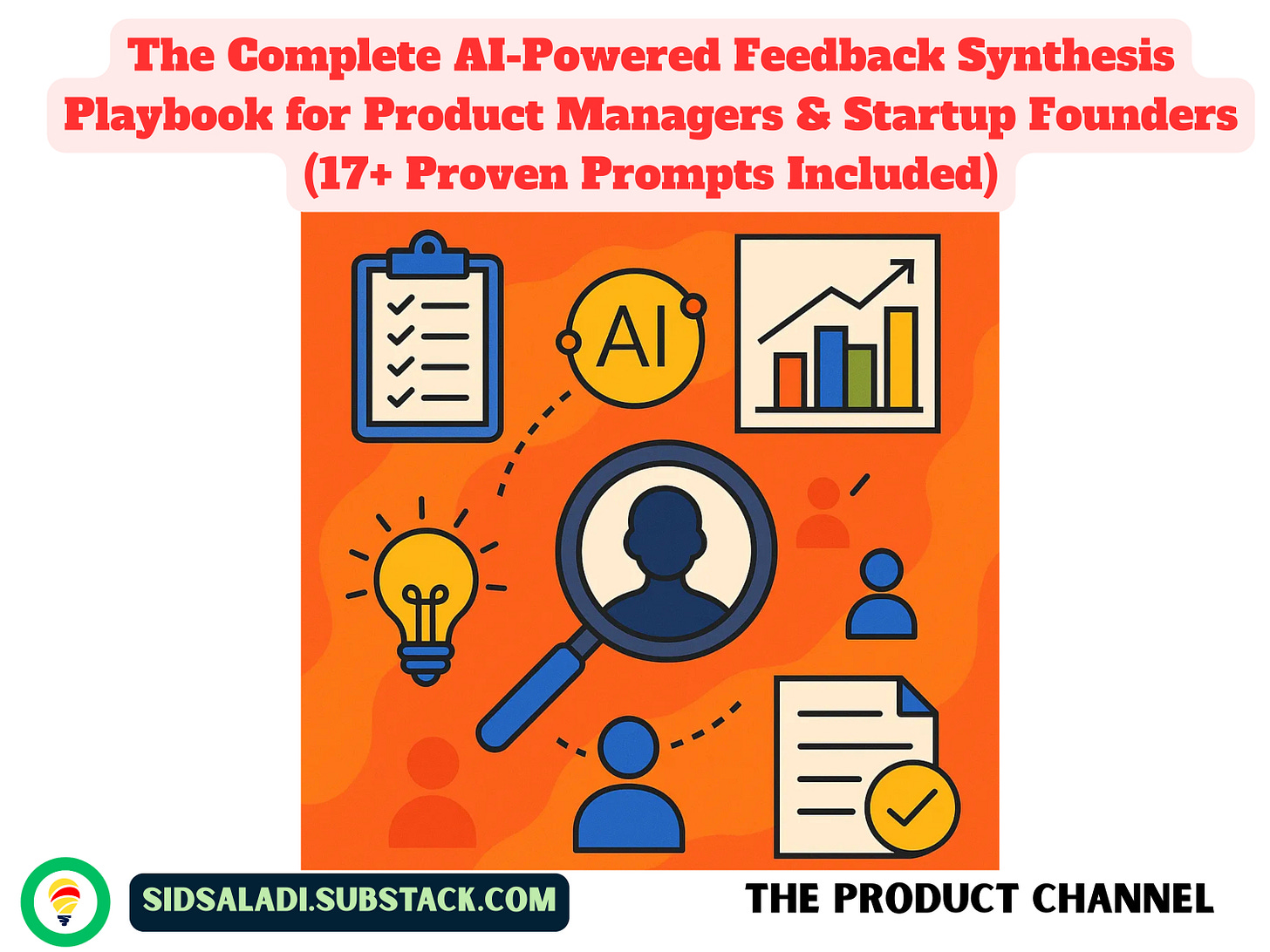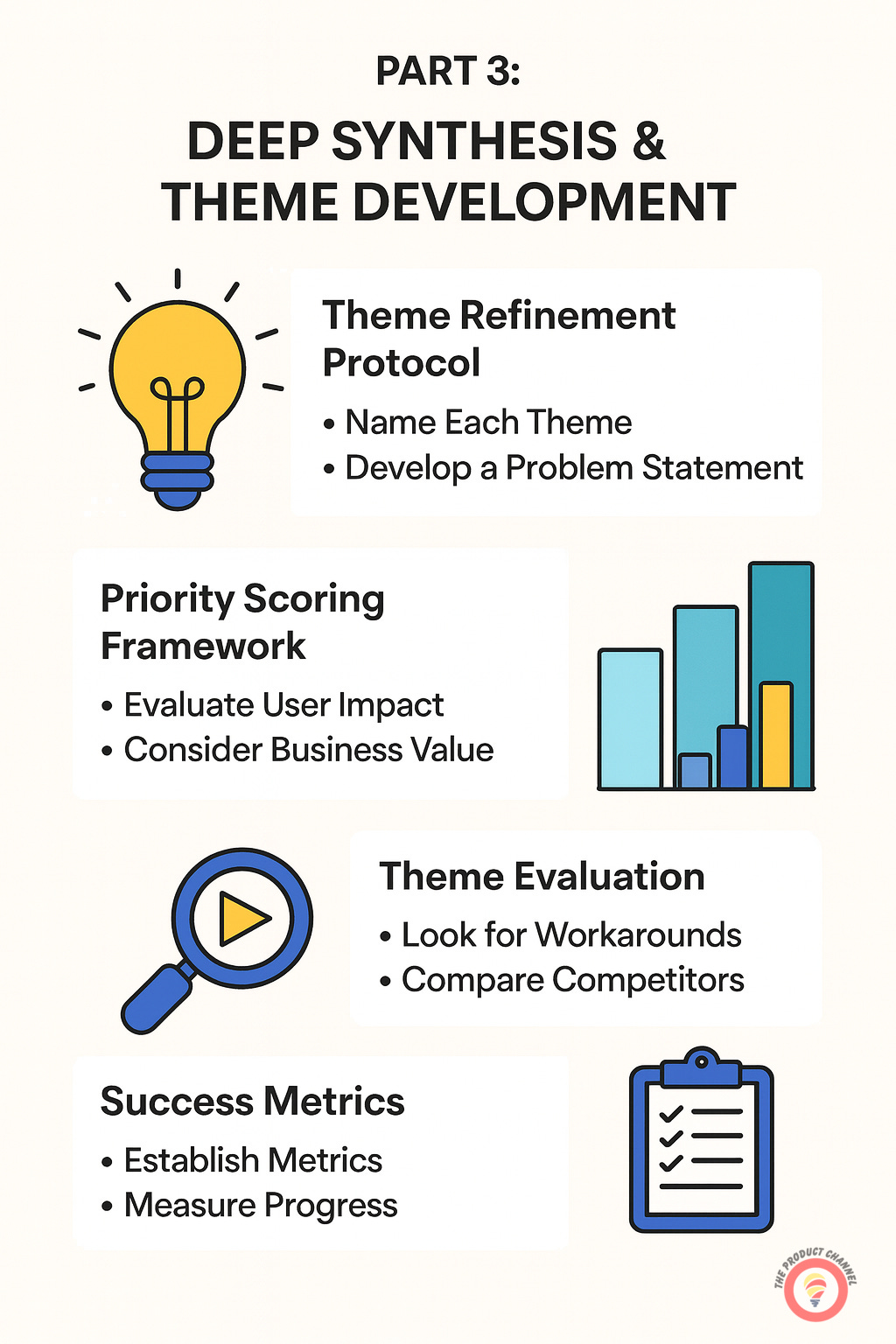17 Battle-Tested AI Prompts That Turn Raw Feedback Into Revenue-Driving Features
Table of Contents
Introduction
The High Cost of Untapped Feedback
Why AI-Powered Synthesis is the Competitive Edge
Part 1: Understanding Your Feedback Sources & Synthesis Potential
Support Tickets & Customer Service Interactions
User Interviews & Usability Tests
Surveys & Structured Feedback
App Store Reviews & Online Forums
Analytics & Behavioral Data
AI Model Selection Guide
Part 2: The Master Synthesis Workflow
Stage 1: Data Collection & Preparation
Phase 2: Initial AI Analysis
Source-Specific Summarization Prompts
Cross-Source Pattern Recognition
🔒 Part 3: Deep Synthesis & Theme Development
Theme Refinement Protocol
Priority Scoring Framework
🔒 Part 4: Validation & Verification
AI Hallucination Check
Stakeholder Validation Framework
🔒 Part 5: Actionable Output Creation
Executive Summary Generation
Development-Ready Documentation
🔒 Part 6: Advanced Synthesis Techniques
Predictive Theme Analysis
Competitive Intelligence Synthesis
Multi-Modal Analysis
Sentiment Evolution Tracking
🔒 Part 7: Visualization & Communication Templates
Executive Dashboard Template
Stakeholder Communication Templates
Visual Synthesis Formats (Journey Maps, Priority Matrix, Theme Timeline)
🔒 Part 8: Common Pitfalls & How to Avoid Them
Hallucination Trap
Sampling Bias Blindness
Over-Automation Syndrome
Analysis Paralysis
Tool Sprawl
Over-Categorization Trap
Echo Chamber Effect
🔒 Part 9: Measuring Success & ROI
Key Performance Indicators (Efficiency, Quality, Business Impact)
ROI Calculation Framework
Success Tracking Template
🔒 Part 10: Future-Proofing Your Synthesis Process
Building Organizational Capabilities (Individual → Team → Org)
Continuous Improvement Framework
🔒 Part 11: Advanced Techniques That 10x Your Results
Segment Sniper
Time Machine Method
Contradiction Hunter
Correlation Compass
The $100,000 Problem Hiding in Your Feedback Backlog
Every week, your product generates thousands of data points: support tickets pile up, survey responses flood in, app reviews accumulate, and user interview transcripts gather digital dust. McKinsey research shows the average product team spends 40% of its time on data analysis, yet 73% of customer insights never make it into product decisions.
Here's the costly reality: while you're manually sorting through feedback, competitors using AI-powered synthesis are shipping features 5x faster and achieving 40% higher product-market fit scores. Teams report saving $21,000 annually per person through AI adoption, with some reducing research synthesis time from weeks to hours.
This comprehensive playbook will show you exactly how to leverage AI tools like ChatGPT, Claude, Gemini, and specialized platforms to transform scattered feedback into crystal-clear product priorities. Whether you're a solo founder or leading a product team at scale, you'll learn the exact workflows, prompts, and strategies that top-performing teams use to maintain customer obsession at startup speed.
Here's a feedback dataset from a hypothetical company, "FlowTrackr," that you can use to test the prompts in this playbook before applying them to your actual data:
FlowTrackr_Complete_Feedback_Dataset.xlsx
Part 1: Understanding Your Feedback Sources & Synthesis Potential
The Modern Feedback Ecosystem
Product teams today collect feedback across an unprecedented number of channels. Understanding the unique characteristics and synthesis potential of each source is critical for effective AI implementation.
Support Tickets & Customer Service Interactions
Volume: 100-10,000+ monthly
AI Synthesis Potential: Excellent for pattern detection, automatic categorization, urgency scoring
Key Insight Types: Immediate pain points, workflow friction, feature confusion
Best AI Approach: Sentiment analysis + topic clustering + priority scoring
User Interviews & Usability Tests
Volume: 5-50 per quarter
AI Synthesis Potential: Superior for emotional context, motivation extraction, quote mining
Key Insight Types: Deep user psychology, job-to-be-done, unmet needs
Best AI Approach: Transcript analysis + thematic coding + journey mapping
Surveys & Structured Feedback
Volume: 100-10,000+ responses
AI Synthesis Potential: Ideal for statistical confidence, trend identification
Key Insight Types: Quantified preferences, satisfaction drivers, feature priorities
Best AI Approach: Open-text analysis + correlation detection + segmentation
App Store Reviews & Online Forums
Volume: Continuous stream
AI Synthesis Potential: Excellent for unfiltered sentiment, competitive intelligence
Key Insight Types: Public perception, viral issues, feature requests
Best AI Approach: Real-time monitoring + sentiment tracking + competitive analysis
Analytics & Behavioral Data
Volume: Millions of events
AI Synthesis Potential: Powerful when combined with qualitative feedback
Key Insight Types: Usage patterns, feature adoption, user flows
Best AI Approach: Correlation analysis + predictive modeling + cohort analysis
AI Model Selection Guide for Feedback Synthesis
Before we dive into other sections where we explore different prompts for various situations, here is a guide to help you select the right AI model for different feedback synthesis use cases:
Part 2: The Master Synthesis Workflow
Data Collection & Preparation (2-3 hours)
1.1: Create Your Feedback Inventory
□ Export last 90 days of support tickets
□ Compile recent user interview transcripts
□ Download survey responses (CSV format)
□ Scrape app store reviews (last 200-500)
□ Export NPS comments and CSAT feedback
□ Gather sales team's "reasons for churn"
□ Pull customer success "feature requests"
1.2: Data Cleaning Protocol
Remove all PII (names, emails, company names)
Standardize date formats (YYYY-MM-DD)
Convert all files to UTF-8 encoding
Create source attribution tags
Split mega-files into 50-100 item chunks
1.3: Create Analysis Framework
Your data structure should look like:
feedback_id | source | date | user_segment | text | sentiment | category 001 | survey | 2024-01-15 | enterprise | "Login is too slow" | negative | performance
Initial AI Analysis (1-2 hours)
2.1: Source-Specific Summarization
This is where 90% of PMs fail. They use generic prompts and get generic insights.
Here's my battle-tested prompt structure that actually works:
# USER INTERVIEW ANALYSIS REPORT
## Interviewee: [Full Name]
## Executive Summary
[Brief overview of key findings - 3-4 sentences maximum]
## Top Pain Point Themes
1. [Theme Name] - [Total Mentions]
* Description: [Theme description]
* Pain Points: [List of pain points in this theme]
2. [Theme Name] - [Total Mentions]
...
3. [Theme Name] - [Total Mentions]
...
## Detailed Pain Point Breakdown
### Theme: [Theme Name] ([X] total mentions)
Description: [Brief theme description]
#### Pain Point: [Pain Point Name] - Mentioned [X] times
* Description: [Brief description of the specific pain point]
* Supporting Quotes:
* "[Direct quote from transcript]" - [Interviewee Name]
* "[Direct quote from transcript]" - [Interviewee Name]
#### Pain Point: [Pain Point Name] - Mentioned [X] times
...
### Theme: [Theme Name] ([X] total mentions)
...Support Ticket Analysis Prompt:
You are a product analyst reviewing customer support tickets.
Context: [Product name and brief description]
Data: [Paste 50-100 support tickets]
Analyze and provide:
1. Top 5 issue categories with frequency counts
2. Severity breakdown (critical/high/medium/low)
3. Resolution time patterns
4. Common user confusion points
5. Feature gaps indicated by workaround requests
6. Direct quotes illustrating key pain points
7. Quick-fix opportunities vs. structural problems
Format as a structured report with actionable recommendations for Product and Engineering teams.App Store/Online Review Analysis Prompt:
You are a product insights specialist analyzing public reviews.
Context: [Product name, category, and target audience]
Data: [Paste 50-100 reviews]
Analyze and provide:
1. Star rating distribution and trends over time
2. Primary positive themes with representative quotes
3. Primary negative themes with representative quotes
4. Competitor comparisons mentioned
5. Feature requests (explicit and implicit)
6. User segments providing feedback (if identifiable)
7. Critical bugs or technical issues reported
Format as a structured report that compares our standing against competitors and identifies immediate action items.
Analytics Data Analysis Prompt:
You are a product analytics expert interpreting user behavior data.
Context: [Product name, key features, and typical user flow]
Data: [Paste key metrics or analytics export]
Analyze and provide:
1. User journey bottlenecks (high drop-off points)
2. Feature adoption rates and trends
3. User segments with distinct usage patterns
4. Correlation between feature usage and retention
5. Anomalies or unexpected behavior patterns
6. Growth opportunities based on usage trends
7. Recommended A/B tests to improve metrics
Format as a data-driven report with clear visualizations described and actionable insights for the product team.2.2: Cross-Source Pattern Recognition
After individual analysis, combine insights:
I've analyzed feedback from multiple sources about [product]. Here are the summaries:
Survey Summary: [Paste]
Interview Summary: [Paste]
Support Ticket Summary: [Paste]
Review Summary: [Paste]
Identify:
1. Themes that appear across 2+ sources (with source breakdown)
2. Conflicts or contradictions between sources
3. User segment differences in feedback patterns
4. Temporal patterns (issues getting better/worse over time)
5. Root causes connecting surface-level complaints
6. Priority matrix: Impact (1-10) x Frequency (%) x Feasibility (1-10)
Create a unified problem statement for each major theme.Part 3: Deep Synthesis & Theme Development (2-3 hours)
Keep reading with a 7-day free trial
Subscribe to The Product Channel By Sid Saladi to keep reading this post and get 7 days of free access to the full post archives.





